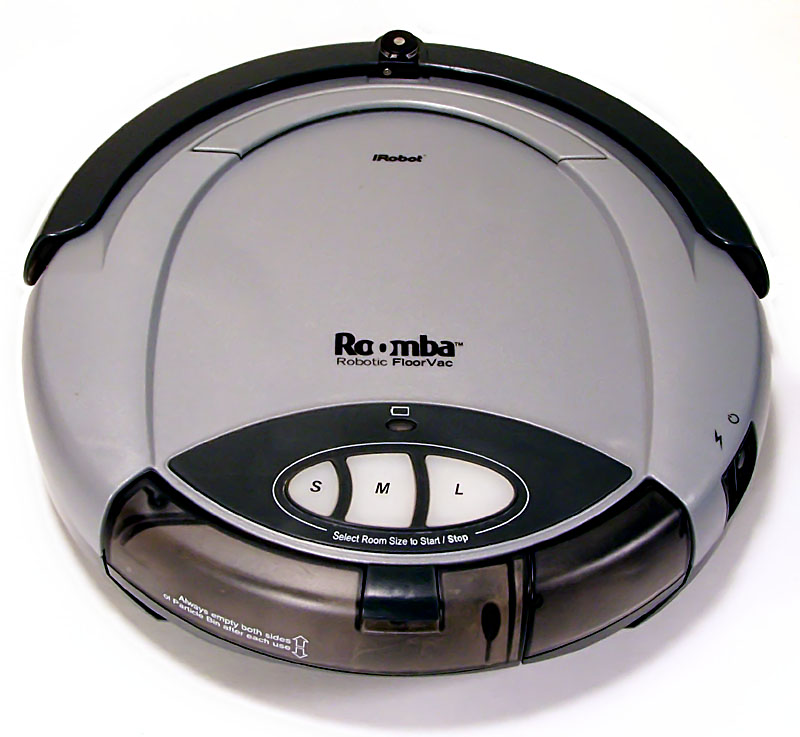Ruumba – iRobot’s Roomba and GLaDOS from Portal
https://wiki.wizard101central.com/wiki/NPC:Ruumba
https://en.wikipedia.org/wiki/Roomba
https://en.wikipedia.org/wiki/GLaDOS
Ruumba is a sentient sanitation bot that lives in the Zanadu Sewers. Wizards seek Ruumba’s assistance in order to find the Aethyrium. He and the other Sani-bots are programmed to keep the sewer clear of Shadow creatures.
The sewers are in danger of flooding out into the streets above. Ruumba would adjust the drainage valves but he finds that work tedious.
Roomba is a series of autonomous robotic vacuum cleaners made by the company iRobot, introduced in September 2002. The vacuums have a set of sensors used to help them navigate the floor area of a home. These sensors can detect the presence of obstacles and steep drops (e.g., to avoid falling down stairs)
Engineer Joe Jones first conceived of what eventually became the Roomba in 1989 while working at the MIT Computer Science and Artificial Intelligence Laboratory. His initial design stemmed from a challenge amongst colleagues to create something cool using Lego. Early prototypes were created and presented to the Denning Mobile Robot Company and Bissell in the 1990s, but neither company was interested in producing them. The concept languished until 1999 when S.C. Johnson eventually agreed to fund the project at iRobot. The device was initially called “DustPuppy” before being renamed to Roomba. Development began in full in December 1999. S.C. Johnson pulled out after spending US$1–2 million, but iRobot proceeded with the project, leading to the launch of the first Roomba in September 2002.
As of 2024, iRobot markets models of their fourth through tenth generation, although it continues to provide support and sell accessories for its previous series. Various models have different features, including tangle-free brushes, separate sweep canisters, more powerful vacuums, obstacle avoidance, and performance maps displayed via smartphone apps. Newer high-end models also have a camera, which works in conjunction with onboard mapping and navigation software to systematically cover all floor areas, move from room to room, avoid obstacles such as pet waste and charging cables, and find recharging stations.
GLaDOS (Genetic Lifeform and Disk Operating System) is a fictional character from the video game series Portal. The character was created by Erik Wolpaw and Kim Swift and voiced by Ellen McLain. GLaDOS is depicted in the series as an artificially superintelligent computer system responsible for testing and maintenance in the Aperture Science Computer-Aided Enrichment Center in all titles. While GLaDOS initially appears in the first game to simply be a voice that guides the player, her words and actions become increasingly malicious as she makes her intentions clear. The second game, as well as the Valve-created comic Lab Rat, reveals that she was mistreated by the scientists and used a neurotoxin to kill the scientists in the laboratory before the events of the first Portal. She is apparently destroyed at the end of the first game but returns in the sequel, in which she is supplanted by her former intelligence dampener and temporarily stuck on a potato battery, while her past as the human Caroline is also explored.

The inspiration for the character’s creation extends from Wolpaw’s use of a text-to-speech program while writing lines for the video game Psychonauts. Other game developers working on Psychonauts found the lines funnier as a result of the synthesized voice. GLaDOS was originally intended to be present solely in the first area of Portal; she was well received by other designers and her role was expanded as a result. Play testers were motivated to complete tests in the game due to her guidance. While the game was initially designed with other characters, they were later removed, leaving GLaDOS as the only character players encounter. The physical appearance of GLaDOS went through several designs, one of which featured a large disk below her. McLain imitated dialog read aloud by a speech synthesizer with her own voice, which was then processed to sound more robotic, and performed songs in character during the closing credits of both entries in the series. “Still Alive” became hugely successful, notably appearing in the Rock Band game series, and has been a popular song for YouTube users to cover. GLaDOS later appeared in The Lab and Lego Dimensions.
The current list of all the (known) Empyrea references can be found here.
Although I am well versed in Pop Culture references but I do not claim to have caught them all. Let me know your favorites in the comments and if I’ve missed one you caught, let me know so I can add it to the list.
Text for this article is excerpted from the linked wiki pages
Ruumba image is from Wizard101, and is copyright of KingsIsle Entertainment.
Roomba image is borrowed from Wikipedia and is copyright Larry D. Moore and is shared under the CC BY 4.0 Creative Commons license
GLaDOS image is borrowed from Gamesradar.com and is copyright Microsoft Game Studios
Image usage qualifies as fair use under US copyright law.

